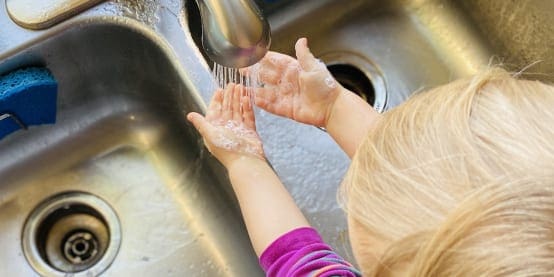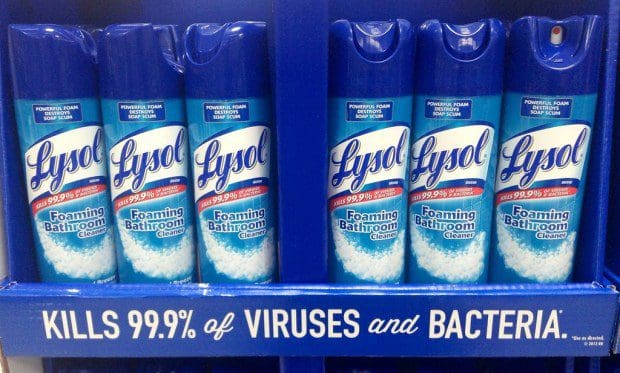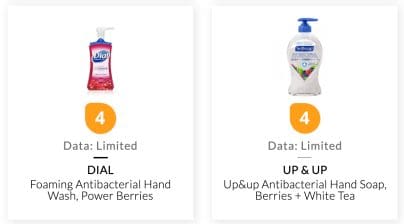SHOULD WE BE USING ANTIBACTERIAL AGENTS DURING COVID-19 PANDEMIC?
Summary of this literature review:
– Hand washing with non-antimicrobial soap for 20-40 seconds is the best method for removing virus from the hands.
– Killing our bacterial flora internally or topically with antibacterial agents may reduce our ability to fight viruses.
– Exposure to some common disinfectants can damage the lung tissue, increase allergic responses and asthma in response to common allergens and reduce our ability to fight viruses.
Summary for action steps:
– Wash hands for 40 seconds with non-antibacterial soap if you have contacted potentially contaminated surfaces and before touching your face or eating
– Avoid antibacterial agents in soaps, toothpastes, cosmetics, etc and avoid excessive use of drying antibacterial hand sanitizers when possible (wash hands in preference)
– Do not clean with harsh chemicals such as Lysol or bleach
– Support the gut microbiome with fiber, probiotics, avoiding chlorinated water
Agents effective against coronavirus:
- 70% isopropyl alcohol
- Hydrogen peroxide (1 min of exposure)
- Ammonium
- Hand washing with non-medicated soap
Literature review:
Study on hand hygiene techniques against the H1N1 virus:
Subjects hands were inoculated with H1N1. Swabs were taken 2 minutes after the virus was applied.
Swabs were also taken after the 4 hand hygiene procedures were completed:
1. Hand washing for 40 seconds with non-antibacterial liquid soap
2. Hand rubbing with 61.5% ethanol for 20 seconds
3. Hand rubbing with 70% isopropyl alcohol plus 0.5% chlorhexidine for 20 seconds
4. Hand rubbing with 70% ethanol plus 0.5% chlorhexidine for 20 seconds
Results:
6 of 20 subjects had no detectable virus remaining after the 2 min of air drying. The remaining 14 subjects had a 3-4 log reduction in viral load 2 minutes after the hands had air dried. This suggests human hands are not hospitable for virus. Is this related to commensal flora? Is it related to natural oils on our skin?
Hand washing was superior to all other methods for reducing viral load.
Isopropyl alcohol was superior to ethanol. 5
Risk of exposure to antimicrobial agents:
Ammonium: common disinfectant found in cleaners such as Lysol
Case report: Lysol exposure on the skin caused ARDS in a case report. 1
Triclosan: antibacterial that was banned by the FDA in 2017 in some personal care products. Prior to this, it was found in toothpaste, cosmetics, deodorants, personal care products, kitchenware, first aid materials and more. Studies show it is persistent in the environment and is likely present in our water supply. Furthermore, it is still present in Colgate toothpaste.
– Even brief (1 hour) exposure resulted in clinically significant reduction in NK cell activity. NK cells fight virally-infected cells. 2
– Increased allergic response and asthma symptoms: Mice were exposed to triclosan through their skin in the presence of an allergen (egg). The triclosan increased asthma symptoms in response to the allergen (airway hyperactivity, IgE, lung eosinophilic infiltration, and enhanced IL-13 cytokine production). 3
Benzalkonium chloride, benzethonium chloride, and chloroxylenol: these are the replacements for triclosan in personal care products and antibacterial soaps. A study reported in the Environmental Pollution journal in 2018 found that these are no less toxic to triclosan. All three induced birth defects and cause neurotoxicity in zebra fish (closely related genetically to humans) 8.
Source: https://www.ewg.org/skindeep/browse/ingredients/700674BENZALKONIUM_CHLORIDE/?category=liquid+hand+soap
Read labels! Use Skin Deep: https://www.ewg.org/skindeep/ to investigate ingredients in your products.
Impact of killing commensal bacteria on ability to fight virus:
Alcohol-based hand rubs are shown to reduce the resident bacterial flora for 3 hours. 4
In a study evaluating the vaginal microbiome in HPV infected women, researchers looked at correlations between lactobacillus, hydrogen peroxide, and severity of HPV lesions. They found that women with more severe HPV lesions had lower levels of lactobacillus and lower hydrogen peroxide. Hydrogen peroxide is an important immune generated mediator that kills viruses. This suggests that agents that kill vaginal lactobacillus (antibiotics, antibacterial soaps) may increase susceptibility to HPV due to a reduction in vaginal hydrogen peroxide. 6
Intestinal dysbiosis (disruption in the good and bad bacteria) created by antibiotic administration resulted in a reduction of lung miRNA independent of changes in the pulmonary flora. Since miRNA supports anti-viral functions of the immune system, the host was more susceptible to pulmonary influenza. 7
References
1. Liu YY1, Lu CC, Perng RP. Acute respiratory distress syndrome following cutaneous exposure to Lysol: a case report. Zhonghua Yi Xue Za Zhi (Taipei). 1999 Dec;62(12):901-6.
https://www.ncbi.nlm.nih.gov/pubmed/10634006
2. Felicia Udoji, Tamara Martin, Rachel Etherton & Margaret M. Whalen. Journal of Immunotoxicology, Volume 7, 2010 – Issue 3.18 Mar 2010
https://www.tandfonline.com/doi/full/10.3109/15476911003667470
3. Anderson SE1, Franko J, Kashon ML, Anderson KL, Hubbs AF, Lukomska E, Meade BJ.
Exposure to triclosan augments the allergic response to ovalbumin in a mouse model of asthma. Toxicol Sci. 2013 Mar;132(1):96-106. doi: 10.1093/toxsci/kfs328. Epub 2012 Nov 28.
https://www.ncbi.nlm.nih.gov/pubmed/23192912
4. Zandiyeh M1, Roshanaei G2. Effectiveness of three surgical alcohol-based hand rubs on skin flora. Iran J Nurs Midwifery Res. 2015 Mar-Apr;20(2):221-5.
https://www.ncbi.nlm.nih.gov/pubmed/25878700
5. Grayson ML1, Melvani S, Druce J, Barr IG, Ballard SA, Johnson PD, Mastorakos T, Birch C. Efficacy of soap and water and alcohol-based hand-rub preparations against live H1N1 influenza virus on the hands of human volunteers. Clin Infect Dis. 2009 Feb 1;48(3):285-91. doi: 10.1086/595845.
6. Zheng JJ1, Song JH2, Yu CX1, Wang F1, Wang PC3, Meng JW3. Difference in vaginal microecology, local immunity and HPV infection among childbearing-age women with different degrees of cervical lesions in Inner Mongolia. BMC Womens Health. 2019 Aug 12;19(1):109. doi: 10.1186/s12905-019-0806-2.
https://www.ncbi.nlm.nih.gov/pubmed/31405377
7. Pang P1, Yu B2,3, Shi Y4, Deng L5, Xu H6, Wu S7, Chen X8. Alteration of Intestinal Flora Stimulates Pulmonary microRNAs to Interfere with Host Antiviral Immunity in Influenza. Molecules. 2018 Nov 30;23(12). pii: E3151. doi: 10.3390/molecules23123151.
https://www.ncbi.nlm.nih.gov/pubmed/30513647
8. Sreevidya VS1, Lenz KA1, Svoboda KR1, Ma H2 . Benzalkonium chloride, benzethonium chloride, and chloroxylenol – Three replacement antimicrobials are more toxic than triclosan and triclocarban in two model organisms. Environ Pollut. 2018 Apr;235:814-824. doi: 10.1016/j.envpol.2017.12.108. Epub 2018 Feb 21.





